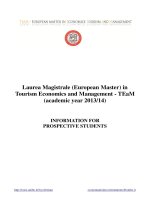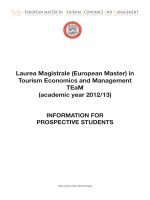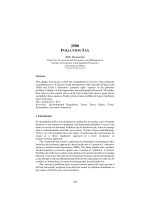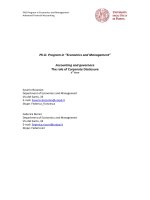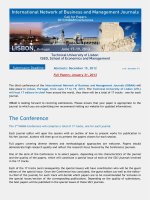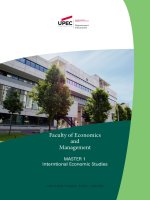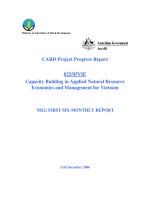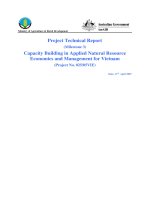school of economics and management department of industrial management
Bạn đang xem bản rút gọn của tài liệu. Xem và tải ngay bản đầy đủ của tài liệu tại đây (4.36 MB, 39 trang )
<span class="text_page_counter">Trang 1</span><div class="page_container" data-page="1">
<b>******** </b>
<b>INTERNSHIP REPORT I PHAM QUOC TRUNG </b>
</div><span class="text_page_counter">Trang 2</span><div class="page_container" data-page="2"><b>Name of student:</b> Pham Quoc Trung <b>Student ID: </b>20198048
<b>Class: EM-NU64B Field of study:</b> Logistics and Supply Chain Management
<b>Company Name: POST AND TELECOMMUNICATION EQUIPMENT </b>
JOINT STOCK COMPANY
<b>Instructor: Ph.D. Tran Thị Bich Ngoc </b>
<b>Evaluation of instructor for student: </b>
</div><span class="text_page_counter">Trang 3</span><div class="page_container" data-page="3"><b>2.3. Objectives of Production/Operations Management ... 14 </b>
<b>2.4. Decision Making in Production/Operations Management. ... 14 </b>
<b>2.5. Problems of Production/Operations management ... 16 </b>
<b>3. Factors affecting Production and Operation Management ... 17 </b>
<b>4. Scope of Production and Operations Management ... 20 </b>
<b>CHAPTER 2: ANALYSIS OF POSTEF’S PRODUCTION AND OPERATIONS MANAGEMENT ... 26 </b>
<b>1. Analysis, planning and management of production activities ... 26 </b>
<b>2. Monitor and supervise production activities ... 30 </b>
<b>4. Recruitment and training management ... 34 </b>
<b>Chapter III: GENERAL EVALUATION ... 36 </b>
<b>1. Advantages ... 36 </b>
<b>2. Disadvantages ... 36</b>
</div><span class="text_page_counter">Trang 4</span><div class="page_container" data-page="4">3
<b>List of Figure </b>
<b>Fig. 1 Schematic production system……….………...5 </b>
<b>Fig. 2 Systems View of Production/Operations Function………..…………7 </b>
<b>Fig. 3 Classification of production systems………...10 </b>
<b>Fig. 4 Scope of production and operations management. ………...23 </b>
<b>Fig.5: Planning process………...26 </b>
<b>Fig 6: Detailed list of TCA-OUT 8-24 Box………... 27 </b>
<b>Fig 7: Material balance sheet of TCA-OUT 8-24 Box...………...28 </b>
<b>Fig 8: Purchase balance sheet………... 28 </b>
<b>Fig 9: Production order………...29 </b>
<b>Fig 10: Production adjustment order………... 30 </b>
<b>Fig. 11: Fiber Optic Factory Instruction (Factory 3) ………...……...31 </b>
<b>Fig. 12: Cable Factory Instruction (Factory 3) ………... 32 </b>
<b>Fig. 13: Factory 2 Instruction ……….………...33 </b>
<b>Fig. 14: Postef’s 5s………... 34 </b>
<b>List of Table </b>
<b>Table 2.4a: Shows some of the responsibilities of productions/operations managers………...15 </b><b>Table 2.4b: The ten decision areas in production/operations management……….…………15 </b>
</div><span class="text_page_counter">Trang 5</span><div class="page_container" data-page="5"><b>CHAPTER 1: FUNDAMENTAL THEORY OF PRODUCTION AND OPERATIONS MANAGEMENT </b>
<b>1. Introduction about Production/Operations Management </b>
Production/operations management is the process, which combines and transforms various resources used in the production/operations subsystem of the organization into value added product/services in a controlled manner as per the policies of the organization. Therefore, it is that part of an organization, which is concerned with the transformation of a range of inputs into the required (products/services) having the requisite quality level.
The set of interrelated management activities, which are involved in
same concept is extended to services management, then the corresponding set
<b>1.1. Content of Production/Operations </b>
Meaning of "Production"
Production implies the creation of goods and services to satisfy human needs. It involves conversion of inputs (resources) into outputs (products). It is a process by which, raw materials and other inputs are converted into finished products. Earlier the word "<b>manufacturing</b>" was used synonymously with the word "<b>production</b>", but nowadays, we use the term "manufacturing" to refer to the process of producing only tangible goods whereas the word "production" (or operation) is used to refer to the process of creating both goods (which are tangibles) as well as services (which are intangibles).
Any process which involves the conversion of raw materials and bought-out
conversion of inputs adds to the <b>value</b> or <b>utility</b> of the products produced by the conversion or transformation process. The utility or added value is the difference between the value of outputs and the value of inputs. The value
<b>addition to inputs is brought about by alteration, transportation, storage or preservation </b>and<b> quality assurance. </b>
</div><span class="text_page_counter">Trang 6</span><div class="page_container" data-page="6">predominantly a service or even a pure service, is also treated as a productive
system”.
<b>1.2. Distinction between Production Management and Operations Management </b>
<b> Production Management refers to the application of management principles </b>
to the production function in a productive system such as a factory or a manufacturing plant. (e.g., steel plant, cement plant, etc.). It involves application of planning, organizing, directing and controlling the production processes employed for the conversion of inputs into outputs in a productive system.
<b>Operations Management</b> refers to a set of activities that creates value in the form of goods and/ or services by transforming inputs into outputs. Operations management designs and operates productive systems or operating systems such as banks, hospitals, hotels, government agencies and manufacturing plants. Operations management includes activities such as organizing work, selecting processes, arranging layouts, locating facilities, designing jobs, measuring performance, controlling quality, scheduling work, managing inventory and planning production. From the above definition of production management and operations management, it becomes clear that there is hardly
</div><span class="text_page_counter">Trang 7</span><div class="page_container" data-page="7">any difference between the two terms. But the two apparent differences between production management and operations management are:
<i>(i) The term “production management” is mainly used for a productive system </i>
where tangible goods are produced; whereas the term “operations management” is more frequently used where various inputs are transformed into intangible services.
<i>(ii) Operations management is the more recent term used to activities involved </i>
in the process of transforming inputs into outputs (goods and/or services) in a productive system, whereas the term “production management” (or
manufacturing management) was used earlier to refer to activities related to the process of transforming inputs into outputs (mainly tangible goods).
<b>2. Contents Production/Operation Management 2.1. Nature of Production/Operations </b>
The nature of production or operations can be better understood by viewing the manufacturing function as:
<i>(i) Production/operations as a system, </i>
<i>(ii) Production/operations as an organizational function, </i>
<i>(iii) Production/operations as a conversion or transformation process and (iv) Production/operations as a means of creating utility. </i>
Production/Operations as a System
This view is also known as "<b>systems concept of production</b>". A system is defined as the collection of interrelated entities. The systems approach views any organization or entity as an arrangement of interrelated parts that interact in ways that can be specified and to some extent predicted. Production is viewed as a system which converts a set of inputs into a set of desired outputs. A production system has the following elements or parts: (i) Inputs, (ii) Conversion process or transformation process, (iii) Outputs (iv) Transportation subsystem, (v) Communication subsystem and (vi) Control or decision-making subsystem.
</div><span class="text_page_counter">Trang 8</span><div class="page_container" data-page="8"><b>Production/Operations as a Conversion/Transformation Process </b>
The conversion or transformation sub-system is the core of a production system because it consists of processes or activities wherein workers, materials, machines and equipment are used to convert inputs into outputs, i.e.,
The conversion process may include manufacturing processes such as cutting, drilling, machining, welding, painting, etc., and other processes such as packing, selling, etc.
Any conversion process consists of several small activities referred to as
<b>"operations" which are some steps in the overall process of producing a </b>
product or service that leads to the final output.
</div><span class="text_page_counter">Trang 9</span><div class="page_container" data-page="9">Production/Operations as a Means of Creating Utility
Production is defined as the process of adding to the value of outputs or the process of creating utility in outputs. "Utility" is the power of satisfying human needs. During the process of converting the raw materials into finished goods, various types of utilities are created while adding value to the outputs. These types of utilities are:
<i>(i) </i><b>Form utility:</b> which is created by changing the size, shape, form, weight, color, smell of inputs in order to make the outputs more useful to the customers.
<i><b>(ii) Place utility: which is created by changing the places of inputs or </b></i>
transporting the inputs from the source of their availability to the place of their use to be converted into outputs.
<i><b>(iii) Time utility: which is created by storage or preservation of raw materials </b></i>
or finished goods which are in abundance sometime, so that the same can be used at a later time when they become scarce due to higher demand exceeding the quantity available.
<i>(iv) </i><b>Possession utility:</b> which is created by transferring the possession or ownership of an item from one person to another person.
<i>(v) </i><b>Service utility:</b> which is the utility created by rendering some service to the customer.
<i>(vi) </i><b>Knowledge utility:</b> which is created by imparting knowledge to a person. The activities carried out while creating the utilities discussed above are referred to as production functions.
Production Function
Production function may be defined as the creation of useful products for sale with the help of inputs such as materials, machines, labor, land, capital and management. The production function represents basically a physical relationship between inputs and outputs. It may be represented as
where ‘Q’ is the quantity of output and a, b, c, d, etc., represent the quantities of various inputs such as material, machine hours, labor hours, energy, etc., The production function specifies the number of outputs resulting from the number of inputs used during a specified period of time. The productive use of the resources is described by the term <b>productivity</b>. Productivity is an index that measures outputs (goods and services) relative to the inputs (materials, energy and other resources).
</div><span class="text_page_counter">Trang 10</span><div class="page_container" data-page="10">9 It is usually expressed as, Productivity = Output/Input
Productivity is also known as <b>productive efficiency</b> or the <b>efficiency of the production process. It indicates how well a productive process is carried out to </b>
convert a set of inputs into a set of outputs of value to the customer which also provides reasonable profits to the manufacturer or seller.
Importance of Production Function
The production is the core function of any business organization. Production function creates goods and services and organizations exist primarily to create goods and/or to provide services. Without production function, there would be no need for any other function such as marketing, finance or human resource function. Also, more than 50 per cent of employees in a business organization have jobs in the area of production. Moreover, the production function is responsible for a major portion of assets in most organizations. Consumption of goods and services is an integral part of any society and production function facilitates creation of goods and services for the benefit of people in the society.
Some of the areas in which production/operations management can offer competitive advantage to a firm:
Shorter new product lead time (i.e., speed to market). Higher inventory turnover (i.e., low inventory). Shorter manufacturing cycle time.
Higher product quality (i.e., reduced defects). Greater flexibility.
Better customer service. Reduced wastages.
Higher productivity (i.e., reduced costs).
<b>2.2. Production/Operations Systems 2.2.1 Production System </b>
The production system of an organization is that part, which produces products of an organization. It is that activity whereby resources, flowing within a defined system, are combined and transformed in a controlled manner to add value in accordance with the policies communicated by management. A simplified production system is shown above.
The production system has the following characteristics:
1. Production is an organized activity, so every production system has an objective.
2. The system transforms the various inputs to useful outputs. 3. It does not operate in isolation from the other organization system.
</div><span class="text_page_counter">Trang 11</span><div class="page_container" data-page="11">4. There exists feedback about the activities, which is essential to control and improve system performance.
<b>Fig. 3 Classification of production systems </b>
Job Shop Production
Job shop production are characterized by manufacturing of one or few quantities of products designed and produced as per the specification of customers within prefixed time and cost. The distinguishing feature of this is low volume and high variety of products.
A job shop comprises of general-purpose machines arranged into different departments. Each job demands unique technological requirements, demands processing on machines in a certain sequence.
<i>Characteristics </i>
The Job-shop production system is followed when there is: 1. High variety of products and low volume.
2. Use of general-purpose machines and facilities.
3. Highly skilled operators who can take up each job as a challenge because of uniqueness.
4. Large inventory of materials, tools, parts.
5. Detailed planning is essential for sequencing the requirements of each product, capacities for each work center and order priorities.
<i>Advantages </i>
Following are the advantages of job shop production:
1. Because of general purpose machines and facilities variety of products can be produced.
2. Operators will become more skilled and competent, as each job gives them learning opportunities.
</div><span class="text_page_counter">Trang 12</span><div class="page_container" data-page="12">11 3. Full potential of operators can be utilized.
4. Opportunity exists for creative methods and innovative ideas.
<i>Characteristics </i>
Batch production system is used under the following circumstances: 1. When there are shorter production runs.
2. When plant and machinery are flexible.
3. When plant and machinery set up is used for the production of item in a batch and change of set up is required for processing the next batch. 4. When manufacturing lead time and cost are lower as compared to job order production.
<i>Advantages </i>
Following are the advantages of batch production: 1. Better utilization of plant and machinery. 2. Promotes functional specialization.
3. Cost per unit is lower as compared to job order production. 4. Lower investment in plant and machinery.
5. Flexibility to accommodate and process number of products. 6. Job satisfaction exists for operators.
<i>Limitations </i>
</div><span class="text_page_counter">Trang 13</span><div class="page_container" data-page="13">Following are the limitations of batch production:
1. Material handling is complex because of irregular and longer flows. 2. Production planning and control is complex.
3. Work in process inventory is higher compared to continuous production. 4. Higher set up costs due to frequent changes in set up.
Mass Production
Manufacture of discrete parts or assemblies using a continuous process are called mass production. This production system is justified by very large volume of production. The machines are arranged in a line or product layout. Product and process standardization exists and all outputs follow the same path.
7. Flow of materials, components and parts is continuous and without any back tracking.
8. Production planning and control is easy. 9. Material handling can be completely automatic.
<i>Advantages </i>
Following are the advantages of mass production: 1. Higher rate of production with reduced cycle time. 2. Higher capacity utilization due to line balancing. 3. Less skilled operators are required.
4. Low process inventory.
5. Manufacturing cost per unit is low.
</div><span class="text_page_counter">Trang 14</span><div class="page_container" data-page="14">13
<i>Limitations </i>
Following are the limitations of mass production:
1. Breakdown of one machine will stop an entire production line. 2. Line layout needs major change with the changes in the product design. 3. High investment in production facilities.
4. The cycle time is determined by the slowest operation. Continuous Production
Production facilities are arranged as per the sequence of production operations from the first operations to the finished product. The items are made to flow through the sequence of operations through material handling devices such as conveyors, transfer devices, etc.
<i>Characteristics </i>
Continuous production is used under the following circumstances: 1. Dedicated plant and equipment with zero flexibility.
2. Material handling is fully automated.
3. Process follows a predetermined sequence of operations.
4. Component materials cannot be readily identified with final product. 5. Planning and scheduling is a routine action.
<i>Advantages </i>
Following are the advantages of continuous production: 1. Standardization of product and process sequence. 2. Higher rate of production with reduced cycle time. 3. Higher capacity utilization due to line balancing.
4. Manpower is not required for material handling as it is completely automatic.
5. Person with limited skills can be used on the production line. 6. Unit cost is lower due to high volume of production.
<i>Limitations </i>
Following are the limitations of continuous production:
1. Flexibility to accommodate and process number of products does not exist.
</div><span class="text_page_counter">Trang 15</span><div class="page_container" data-page="15">2. Very high investment for setting flow lines. 3. Product differentiation is limited.
<b>2.2.2. Operations system </b>
Operating system converts inputs to provide outputs which are required by a customer. It converts physical resources into outputs, the function of which is to satisfy customer wants i.e., to provide some utility for the customer. In some of the organization the product is a physical good (hotels) while in others it is a service (hospitals). Bus and taxi services, tailors, hospital and builders are the
<b>examples of an operating system. </b>
Everett E. Adam & Ronald J. Ebert define operating system as, “<i>An operating system (function) of an organization is the part of an organization that produces the organization’s physical goods and services.” </i>
<i>Ray Wild defines operating system as, “An operating system is a configuration of resources combined for the provision of goods or services.”</i>
<b>2.3. Objectives of Production/Operations Management </b>
Some of the important objectives of production/operations management are: Maximum customer satisfaction through quality, reliability, cost and
delivery time.
Minimum scrap/rework resulting in better product quality. Minimum inventory levels (i.e., optimum inventory levels). Maximum utilization of all kinds of resources needed. Minimum cash outflow.
Maximum employee satisfaction. Maximum production (i.e., outputs). Higher operating efficiency. Minimum production cycle time. Maximum profit or return on investment. Concern for protection of environment. Maximum productivity.
<b>2.4. Decision Making in Production/Operations Management. </b>
What Production/Operations Managers Do?
The production/operations managers manage all activities of the production/operations systems which convert inputs into the desired outputs (goods and services). The production/operations managers have the ultimate responsibility for the creation of goods or provision of services. Even though the kind of jobs that production/operations managers oversee vary from organization to organization, (because of the different products or services involved) their job is essentially managerial. They must co-ordinate the use of
</div><span class="text_page_counter">Trang 16</span><div class="page_container" data-page="16">15 resources through the managerial process of planning, organizing, staffing, directing (or influencing) and controlling.
<b>Table 2.4a: Shows some of the responsibilities of productions/operations managers. </b>
<b>Responsibilities of Production/Operations Managers </b>
projects and scheduling
Organizing Degree of centralization, subcontracting.
Controlling Inventory control, Quality control, Cost control.
A better insight to how production/operations managers manage can be had by examining the decisions in production and operations management, since all managerial functions such as planning, organizing, staffing, directing and controlling involve decision making.
The decisions which production/operations managers make may be classified into three general categories:
(i) <b>Strategic Decisions:</b> Decisions about products, processes and facilities. These decisions are strategically important and have long-term significance for the organization.
demand.
day-to-day activities of the workers, quality of products and services, production costs, overhead costs and maintenance of plant and equipment.
</div><span class="text_page_counter">Trang 17</span><div class="page_container" data-page="17"><b>2.5. Problems of Production/Operations management </b>
The problems involved in production management require two major types of decisions relating to:
<i>(i) Design of the production system. </i>
<i>(ii) Operation and control of the production system. </i>
Decisions related to the design of production system are long-run decisions whereas, decisions related to operations and control of the production system are short-run decisions.
The problems involve the relative balance of the emphasis on such factors as cost, service and reliability of both functional and time performance, which depends on the basic purposes of the total enterprise and on the general nature of goods and services produced. In general, manufacturing organizations emphasize more on cost, consistent with quality and delivery commitments whereas, service organizations may emphasize reliability and service, consistent with cost objectives.
Long-Run Decisions
Long-run decisions related to the design of the production system are: (i) <b>Selection and Design of Products:</b> Product selections and designs with productive capability (i.e., producibility of products) are interdependent.
equipment and processes among the various alternatives considered, the firm's capability to invest in capital assets and its basic approach to production (i.e., job, batch, mass or continuous production) must be considered.
selection of equipment, processes, and tools for economic production which set limits on the cost of outputs. (iv) Job Design: It involves basic organization of work as well as matching workers to their jobs in order to reduce fatigue and improve productivity.
(v) <b>Location of the System:</b> It is a trade-off decision since there is no one best location for a productive system to be located. The balance of cost factors determined by various considerations is critical.
(vi) <b>Facility Layout:</b> This involves decisions related to design capacity, basic modes of production, shifts of working, use of overtime and subcontracting. In addition, operations and equipment must be located in relation to each other such that the overall material handling cost is minimized. Other factors involved are heating, lighting and other utility requirements, the allocation of storage space, washing space and the design of the building to house the layout.
</div><span class="text_page_counter">Trang 18</span><div class="page_container" data-page="18">17 Short-Run Decisions
Short-run decisions related to the operations and control of the system are: (i) <b>Inventory and Production Control:</b> Decisions made are concerned with allocation of productive capacity consistent with demand and inventory policy. Feasible schedules must be worked out and the load on machines and labor and the flow of production must be controlled.
regarding the maintenance effort, maintenance policy and practice recognizing the fact that machine down time may lead to idling of labor and production stoppage resulting in lost sales.
(iii) <b>Quality Control:</b> Decisions must be made to set permissible levels of risk that bad parts are produced and shipped or the risk that good parts are scrapped due to sampling inspection. Inspection costs must be balanced with the probable losses due to passing defective materials or products. Decisions regarding controlling the quality of on-going processes must be taken.
services. Hence, work measurement and wage incentive systems must be developed to control labor costs and to increase labor productivity. (v) <b>Cost Control and Improvement:</b> Day-to-day decisions which involve the balance of labor, material and overhead costs must be made by production supervisors.
The relative importance of these problems of production management varies considerably depending on the nature of the production system. The production manager must be able to sense the relative importance of these various problems in a given situation and take appropriate decisions to solve these problems.
<b>3. Factors affecting Production and Operation Management </b>
Having understood the nature and types of production systems and also various kinds of decisions made by operations managers, it is necessary to know the factors affecting POM today. Of the many factors affecting POM today, six factors are significant. They are:
Reality of global competition,
Quality, customer service and cost challenges, Rapid expansion of advanced production technology, Continued growth of service sector,
Scarcity of production resources, and Social responsibility issues.
</div><span class="text_page_counter">Trang 19</span><div class="page_container" data-page="19">The impact of these factors on production and operations management today is discussed in greater detail in the following paragraphs.
<i>Reality of Global Competition </i>
<b> The world is rapidly transforming itself into a single global economy which </b>
is also referred to as a <b>global village</b> or <b>global landscape</b>. Markets once dominated by local or domestic firms are now vulnerable to competition from firms in all corners of the world. A country's borders no longer provide protection from intense competition from foreign firms. To succeed in global competition, companies must offer quality products at reasonable costs. Also, as companies expand their business to include foreign markets, so too must the operations management function take a broader, more global perspective in order for companies to remain competitive. The trend towards globalization has placed increased emphasis on the logistics of where to locate facilities and the issues associated with moving materials over long distances.
<i>Quality, Customer Service and Cost Challenges </i>
recognize that quality is no longer limited to the POM function but is important in all functional areas throughout the entire organization, a new concept known as <b>total quality management</b> (or TQM in short). However, POM is primarily responsible to ensure that the firm is able to produce the products in the required quantities, in the required quality level, delivering the products to the customers at the desired time schedule and at the minimum possible cost. Quality is no longer limited to the technical requirements of the goods being produced on the manufacturing shop floor. Service quality (i.e., how we deal with our customers on a wide variety of issues affecting customer satisfaction) is equally important.
How companies integrate product quality and service quality, to properly meet the needs of the customers is a major challenge to today's managers. Improving quality in all respects of the business improves customer satisfaction and increases customer loyalty. Today's customers are demanding better quality, more variety and increased responsiveness to their needs all at lower prices.
Rapid Expansion of Advanced Production Technology
Advances in technology in recent years have also had a significant impact on the POM function. Computer-numerical control (CNC) technology, increased automation and robotics have enabled the companies to improve the quality of products that are being manufactured. Information technology facilitates collection of data on individual customers so that the products can be mass customized to meet the needs of individual customers. However, advances in
</div>